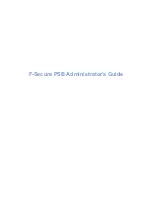
Windows Installer Editor Reference
318
Working With Source Paths
The Registry Path Variable Details dialog box appears.
3. Complete the dialog box:
Variable Name
Enter any name, but do not use special characters or spaces. Because this is not
a Windows Installer property, you do not need to follow Windows Installer
property naming conventions. This variable is inserted into the paths of files
that are pulled from the directory that appears in Current Value.
Current Value
(Read-only.) This shows the current data of the registry value specified below.
Reg. Key
Specify the complete key name of the registry value that contains a directory
path. The registry browser that appears shows only key names (folder icons).
You specify the value in Reg. Value below.
Reg. Value
Select the value to pull a directory name from. This list shows the values
contained in the key you selected above.
Replace When Matched
Mark this to activate this path variable. If this is cleared, this path variable has
no effect on files you add to the installation.
4. Click OK.
See also:
About Path Variables
on page 315
Source Paths in an Installation
Paths to files in an installation can break if you:
z
Move files that are part of the installation to a new directory on your computer or
network.
z
Move the installation file itself from your computer to another computer.
z
Use relative paths and then move the installation file.
z
Rename a directory.
An installation can also contain broken paths if it was created with SetupCapture.
Sometimes, SetupCapture captures references to temporary files that are deleted after
the installation is finished.
If paths are broken, then during compile, error messages appear in the Task List
concerning the files that could not be opened. Rather than adding the files again, you
can specify new source directories for these files. If files with broken paths should not be
in the installation, you can use the Remove Missing Files tool to remove them.
See
Removing Files With Missing or Invalid Source Paths
on page 361.
The Convert Source Paths dialog box lets you change the directories that contain an
installation’s files. You can also change all the directories to either relative or UNC
(Uniform Naming Convention) paths. If you change directories to relative paths, then
the installation can be opened on any computer that has the same relative directory
















































